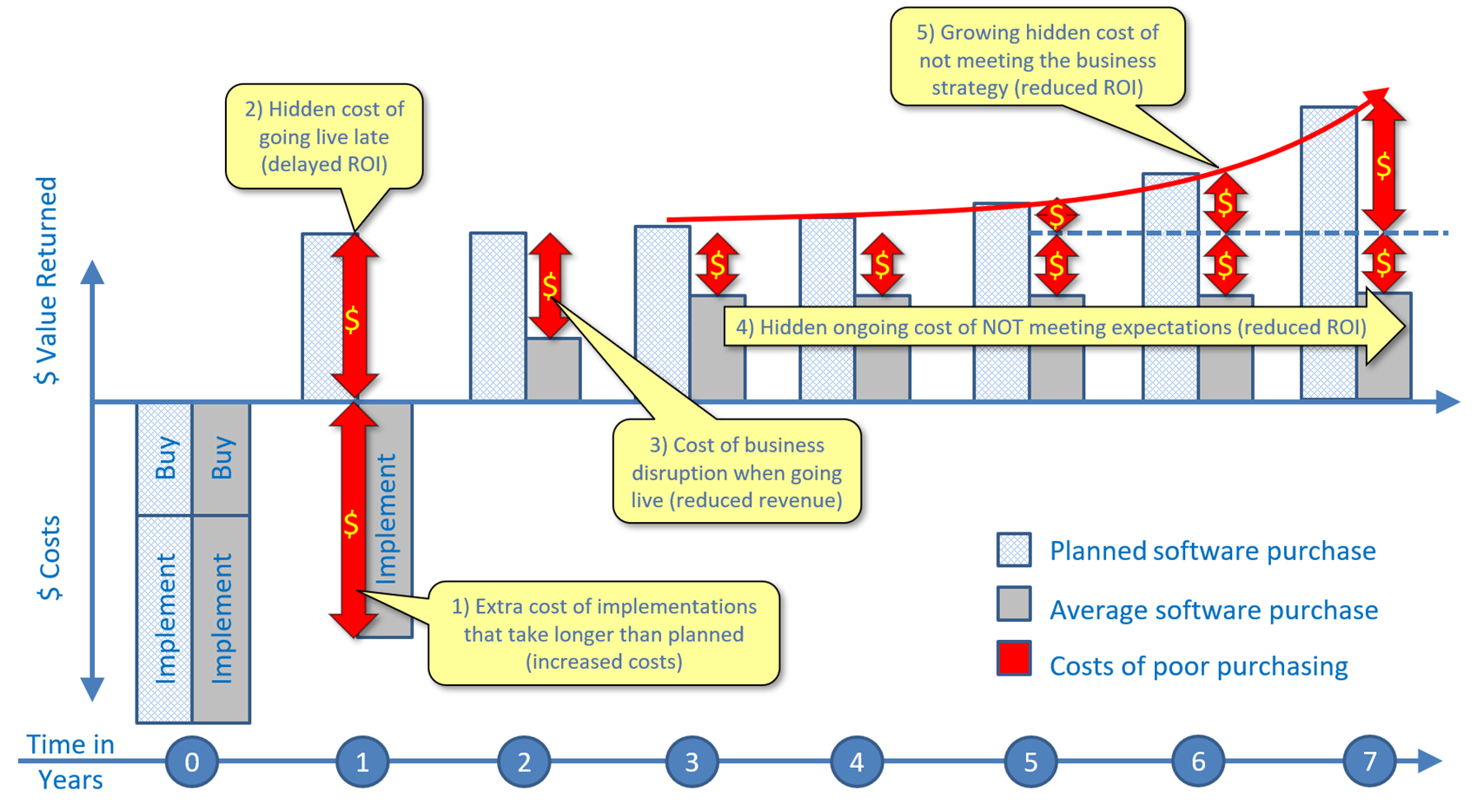The five costs of poor software or ERP purchasing exposed!
Many companies think they know how to purchase software when in reality they have no idea of how little they know about the process! This article looks at the five places where money is squandered when making enterprise software purchases.
Independent enterprise software selection consultants
Companies tolerate the growing pains of inadequate software for years, but once they have decided to replace that software, they can rush headlong into disaster. Enterprise software like ERP is a substantial investment for any organization, especially when you consider the total cost of ownership over the lifetime of the software.
Part of the problem is caused by inadequate attention to the return on the investment in that software. Software itself has no intrinsic value. Rather, the value comes in the form of the value of the benefits that flow from using that software. To illustrate the point, suppose an insurance company spends $1 million per year on labor to process a particular type of claim. If the company introduces new software that reduces labor costs by 20% annually, then the value of that benefit is worth $200k per year to the company.
Categories of benefits
Before purchasing, the value of these benefits should be estimated and factored into the ROI that is used to justify the purchase of the new software. Benefits that flow from using software fall into four categories:
Increases to: revenue, sales, profit, growth, speed…
Decreases in: time, effort, costs, risks, defects, complaints…
Improvements in: efficiencies, capabilities, reporting, processes…
Creation of: strategies, alignments, new businesses, products or services…
To avoid embarking on new software projects that deliver marginal value, you need to estimate the ROI before making the purchase. Also, the differences in ROI between potential software products can be substantial, and usually the software with the greatest ROI is the product that should be selected. For most organizations, the problem is the gap between the anticipated ROI and reality. There are only three objectives that should be met when making a software purchase:
The implementation should go live as planned with minimal disruption to the business.
The software should fit the needs like a “glove fits your hand.”
The software should support the business strategy, e.g. raising the bar on the competition.
Where the money goes
Unfortunately, most organizations take shortcuts with the selection process and usually fail to purchase the software that best fits their particular needs. Even if they do select the best-fit software, inadequate requirements cause multiple problems with the implementation. The chart below compares the net return for a planned software purchase that is used to sell the project internally (blue cross-hatch bars) with what actually happens in practice (gray bars). Red arrows indicate costs that can be minimized or eliminated by optimizing the software selection process.
Chart: Comparing planned versus actual net value returned from a major software purchase like ERP
The typical enterprise software purchase incurs the following unnecessary costs as shown by the red arrows above:
Unexpected implementation costs. An inadequate requirements analysis means that “new” requirements are found during implementation. Dealing with these “new” requirements takes time, and when too many of them accumulate, the implementation schedule slips and costs spiral out of control.
Hidden costs of a delayed ROI. Software is purchased for the value of the benefits of using it. When the implementation is late, that value is reduced. This hidden cost doesn’t show on income statements, but it is very real indeed as can be seen from the red arrow 2 above.
Cost of business disruption when going live. The same problems that delayed the implementation cause disruption to normal business operations when going live.
Hidden cost of unmet expectations. The same problems that caused the implementation to take longer than planned cause the value returned from using the software to be less than expected. This reduced value is indicated by the 5 short red arrows in the chart above and is an ongoing cost that continues for the lifetime of the software. Like the delayed ROI cost, this is another hidden cost that doesn’t show on income statements, but it is very real indeed.
Hidden and growing cost of not meeting business strategy. One of the main reasons for purchasing software is to support the business strategy, e.g. to raise the bar on the competition. When the software doesn’t adequately meet the requirements that business strategy is not supported, e.g. those competitors raise the bar on you and your company ends up competing on price in a commodity market.
Notice that the total of these five costs can be substantially more than the purchase an implementation costs combined. The fact that so many organizations leave that money on the table is absolutely astounding. With the right process, these costs can be minimized or avoided altogether, but they do require significant work upfront when selecting the software.
The key to a successful software purchase lies in the preparation. Think of how much preparation a major sports league team makes before a match. If they winged it without that preparation, they would be slaughtered on the field. When selecting enterprise software, most organizations wing it like an unprepared sports team. The result is the same, only, in this case, it is the bottom line that is slaughtered.
If you recognize you have outgrown your current software or ERP but your team is so busy fighting fires you don’t have time to dial 911, you need help. Companies that sell, implement or support software will always advise you to use their products. Wayferry is an independent consulting firm specializing in software and ERP selection. Click the [Contact Wayferry] button below and let’s explore if we can help you make your next software or ERP purchase an outstanding success.

